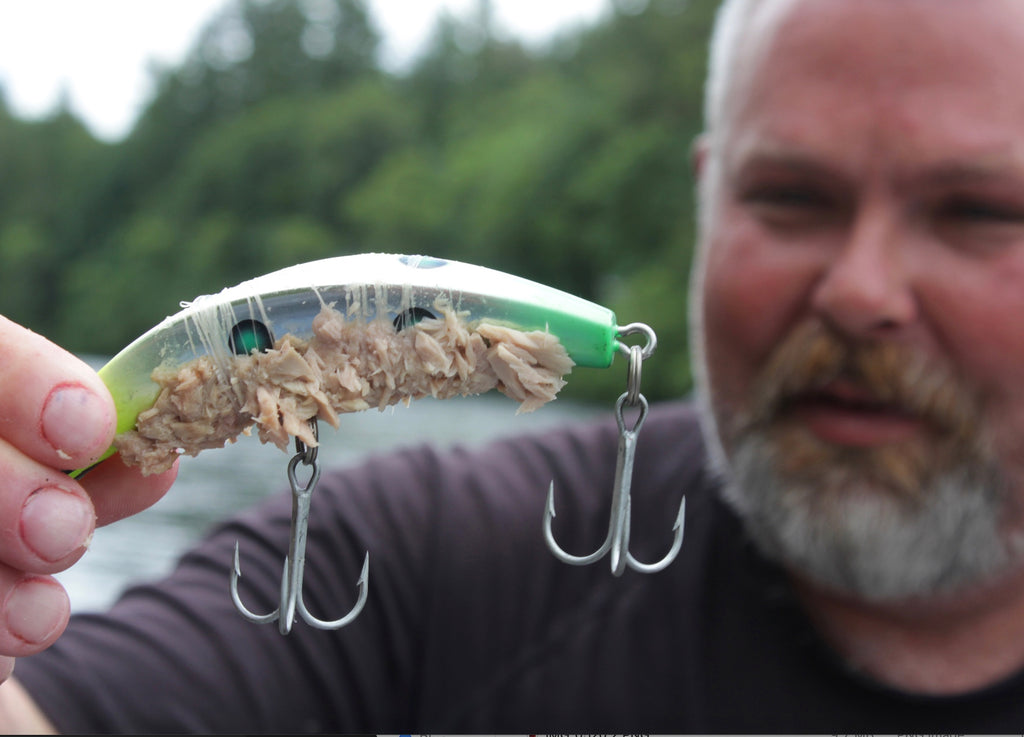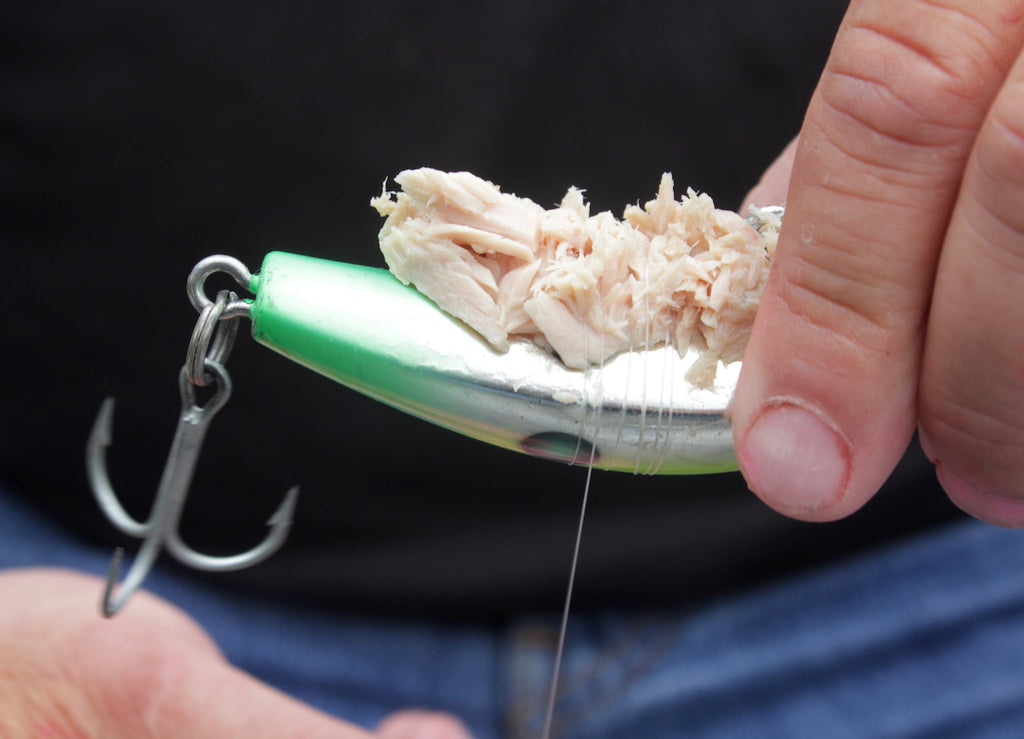No matter what kind of fish you pursue, when you learn something new that really works, it’s just plain exciting.

No sooner had the plugs reached the bend in the river when the inside rod went down. We’d already drift fished the riffle and had run a diver-and-eggs through without so much as a nibble. But the fish couldn’t resist the third offering, a plug wrapped with tuna.
“There he is, Kaz’,” barked an excited Bret Stuart. It was Kazden’s first salmon fishing trip, and his first hookup. Bret and I couldn’t get our lines in the boat fast enough, then all our attention turned to helping Kazden, my son, land his first fish.
Line peeled off fast and Kazden hung on to the rod with all his might. When the chance finally came, Kaz’ worked the fish, trying to get line back.
Finally we caught a glimpse of the fish Kazden was locked in battle with, and Bret and I were both surprised when a chrome-bright summer steelhead revealed itself.
With a final lift of the rod, I scooped the net under the fish and soon we were admiring Kazden’s first steelhead.
Bret nosed the boat into shore and soon we were snapping photos of the fish, capturing a moment we’ll never forget.

In 2006, Bret Stuart first shared his tuna-wrapped plugs with Haugen, and ended up getting Kazden Haugen (4) his first steelhead on the setup. The approach has been working great ever since.
Not only was it Kazden’s first summer steelhead, which at age four was special for all of us, but it was also the first steelhead I’d seen caught on a tuna-wrapped plug. The year was 2006 and since then, we’ve taken a good number of salmon and steelhead on tuna-wrapped plugs.
The Idea
Bret Stuart is a good friend, longtime fishing guide and owner of 24/7 Guide Service in Oregon. Bret and I have shared many great fishing adventures, from Alaska to the McKenzie, a river we both grew up fishing outside of Springfield, Oregon.
One of the things I love about Bret is how hard he works. Not only is he one of the hardest working guides I know, but he’s a hard-working man, period. This equates to a very successful angler whose mind never quits working and who loves doing what he does.
Bret is always experimenting with new things. He’s continually trying out-of-the-ordinary approaches and constantly attempting to figure out what can be done to help his clients catch more fish.
I’ve learned a lot from Bret over the years, and for that I’m grateful. When he told me about wrapping plugs with tuna, and how successful it had been, I couldn’t wait to see it for myself.

In the past I’d wrapped plugs with various baits, from herring to bacon, scent-soaked sponges to squid. But the only way I’d fished tuna on a plug was by wrapping it in a spawn sack (fine, mesh netting) and sliding it on to one of the back hooks. Though this worked, it hasn’t been nearly as effective as wrapping plugs with tuna, the way Stuart taught me.
Creating The Wrap
Stuart starts with a can of tuna, finding oil-packed and water-packed to both be effective. Between his thumb and three fingers he takes a pinch of tuna and positions it on the belly side of the plug. Kwifish, Mag Lips and Hawg Nose Flatfish can all effectively be wrapped in this way.
I know what you’re thinking, “The tuna won’t stay on a plug when wrapped with straight thread.” That’s what I thought.

As Stuart compresses the tuna on to the belly-side of the plug, he offers, “I don’t care if some of the tuna falls off, in fact, I like it. Those little bits of tuna that come loose when the plug works helps create a stronger scent trail that fish can follow.” It’s much like how individual eggs work loose when fishing with roe.
Once the tuna is balanced on the plug, start wrapping it with stretchy thread. This elastic thread binds the tuna chunks, keeping them secure and intact surprisingly well. Even in rough water and when bounced along the bottom, the stretchy thread holds the tuna in place.

The final steps of the wrapping process–throw a few half-hitches and snug them down.
Once you’ve wrapped the tuna securely in place from the tail-end up to the eye of the belly hook, flip the belly hook over on to the already secured tuna and continue wrapping past the eye of the belly hook, toward the bill of the plug.
How far up you go depends on the plug being used and how its action is influenced by the addition of the tuna.
Once the tuna is securely wrapped on to the plug, it’s ready to fish.
What struck me by surprise was how well the tuna chunks adhered to themselves and the plug. After several minutes of being fished in hard, turbulent water, there’s still enough bait on the plugs to keep working (putting out scent). Even after fish hit them, usually enough bait remains in-tact to keep the plug fishable.
The Approach
As with any plug, the approaches are the same when fishing those wrapped with tuna. Depending on what river you’re fishing, what the conditions are like and what plugs you’re fishing, you’ll have to figure out for yourself what works best for you and your specific situation.
Some plugs simply pull better when flatlined while others track just as good with a surprising amount of tuna strapped to them. Experiment around with different combinations in a variety of settings and soon you’ll be dialed-in to what works and what doesn’t.
In deeper holes, a diver may be necessary to help get that wrapped plug down.
Then again, if using Worden’s newest Hawg Nose Flatfish, flatlining down to 20-feet deep is possible under ideal conditions.
There are two schools of thought when running a diver with a tuna-wrap setup.
One is to go with a diver as it relieves some of the stress on the plug, whereby keeping more of the tuna in-tact and on the plug for a longer period.
The other is to forego the diver, allowing the plug to move more aggressively, whereby possibly establishing a heavier scent trail.
There is no right or wrong answer here, as much of what we know, or think we know, in the salmon fishing world is based on speculation. How you choose to fish the setup boils down to personal preference.
Last spring while targeting salmon in one of Oregon’s upper tributaries, Bret and I moved through a deep hole with jumbo divers helping keep our tuna-wrapped plugs close to the bottom. Our goal was to stay deep as it was late morning, the sun was on the water and several boats had already passed through the hole.
We had one strike on our first pass, nothing on our second. Then we removed the divers and ran back through the same water. I missed a good strike but Bret connected. On the next pass I tagged a hatchery springer.
The only difference in those final passes was that we used no diver, just tuna-wrapped plugs.
Whether the fish were suspended a bit off the bottom or liked the action of the plug better without a diver we’ll never know, but the fact remains they were responsive to the change.
Since Bret first shared his tuna-wrapped plug idea with me, I’ve been amazed at the number of summer steelhead we’ve caught on them.
The large majority of these steelhead have come in deeper, heavier water than where many anglers normally target them. Not only does it show that tuna-wrapped plugs have a place in the steelheader’s arsenal, but it’s a reminder of how aggressive these fish are when attacking oversized plugs like these, and how scent can play a role in catching more steelhead.
One thing I have found through using tuna-wrapped plugs is that they seem to produce bites when everything else often fails.
I don’t know if this is because the fish simply respond to a different scent being in the water or the fact they just got agitated into biting. But all too often I’ve experienced fishing holes with other baits–or plugs with no wrapped bait–without so much as a strike, then when switching to tuna-wrapped plugs, the bite turned on.

With a fresh can of tuna and some stretchy thread, you’re ready to wrap your own plugs.
When fishing upper tributary streams in the spring and early summer, salmon often nose-up against rock ledges at various depths. Running tuna-wrapped plugs into these settings at various depths has definitely helped increase our catch rates.
Some of the most impressive success I’ve seen with tuna-wrapped plugs is how well they produce when fished behind other anglers. Be it amid heavy boat traffic or intense bank pressure, the tuna simply ignites a spark that eggs, shrimp and other baits don’t always produce. Again, why this happens is largely based on speculation, but my gut feeling is it comes down to change.
Have you ever fished a salmon hole for a few hours and not gotten a single strike?
Then, when you pull out and another angler steps in, they hook a fish on their first cast? The fish were always there, it’s just that the following angler offered them something new–a smell or sight the fish couldn’t resist.
I believe some of the success found in fishing tuna-wrapped plugs lies in the fact not many anglers are using them.
Salmon are scent junkies, and any time you can introduce a new smell to them, there’s no telling what might happen.
This spring try wrapping some plugs with tuna and see what happens. If change is hard for you to swallow, go at it slowly. If there are multiple anglers in the boat, try wrapping one or two plugs with tuna, the others with your bait of choice.
Give the tuna a fair chance and don’t give up too quickly. Based on my last six years of using this approach, and what I hear from my buddy Bret Stuart, this isn’t a fad that’s going to pass with time. My prediction is tuna-wrapped plugs are here to stay.
- written by Scott Haugen
All photos taken by Scott Haugen

